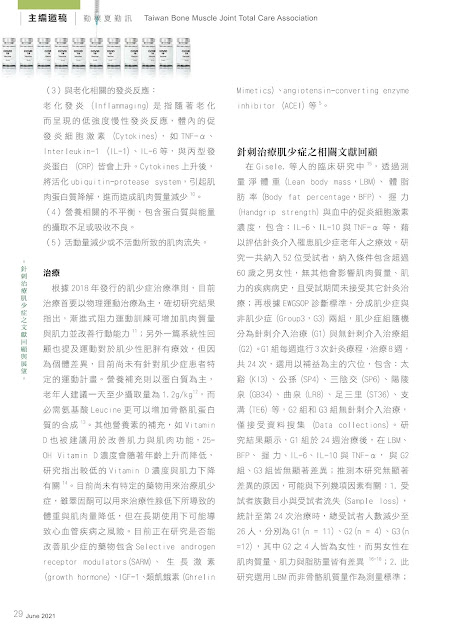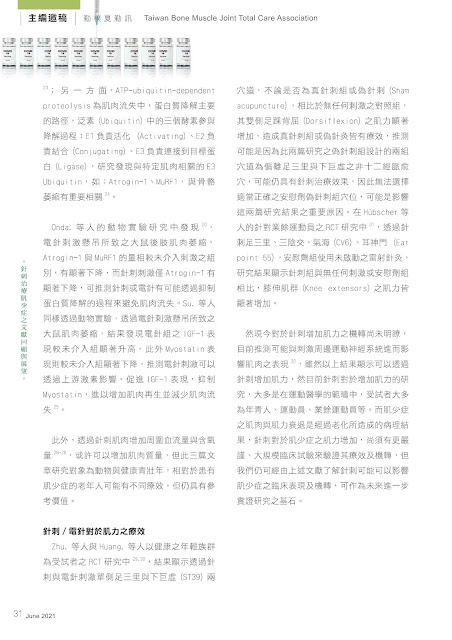[論文發表]
Herbal Formula SS-1 Increases Tear Secretion for Sjögren’s Syndrome
中藥複方SS-1可增加修格蘭氏症患者之淚液分泌
這是臺灣本土第一篇中藥治療修格蘭氏症的隨機、雙盲、交叉、安慰劑對照臨床試驗,
收案一年半,總共前後做了四年,後續又繼續進行到現在,
不是很容易,
前幾個月是SS-1的T細胞機轉被接受,
今天主論文SS-1中藥修格蘭氏症臨床試驗終於被Frontiers in Pharmacology接受了,IF=5.810
目前研究團隊SS-1系列已發表:
1.臨床試驗主論文:Herbal formula SS-1 increases tear secretion for Sjögren’s syndrome. Frontiers in Pharmacology (SCI, 2021 IF= 5.810,第一作者)
2.SS-1 T細胞: Chinese herbal medicine SS-1 inhibits T cell activation and ameliorates TH responses in Sjögren’s syndrome. Journal of the Formosan Medical Association. 2020 (SCI, 2021 IF= 3.282,共同第一作者)
3.臨床試驗前調查:The Core Pattern Analysis on Chinese Herbal Medicine for Sjögren's syndrome: A Nationwide Population-Based Study. Scientific Reports. 2015, 5: 9541 (SCI, 2021 IF=4.379,第一作者)
然後還有SS-1調控粒線體撰寫中......
還需要繼續努力
感謝指導教授張恒鴻老師碩博士班研究路上的教導與提攜,引發我對風濕免疫疾病的興趣,讓我在臨床及研究可以一步步發想、築夢、奠基、踏實,並時時提醒我所作所為要讓這個社會更美好,對社會有貢獻。感謝指導教授魏耀揮老師在粒線體研究的指導,教導我研究的嚴謹度與邏輯性,並能以身作則的告訴我一位教師應該怎麼從心關懷及教導學生。感謝指導教授潘台龍老師的提攜,讓我在研究方法可以更深入奠基,並讓我能排除萬難完成研究。
雖然博士研究的過程很苦,加上修格蘭氏症臨床試驗收案的漫長過程更苦,如果能讓我重選一次研究主題,我還是會義無反顧再進行修格蘭氏症中醫藥臨床試驗,在研究收案過程上及臨床門診遇到的困難,也能一直督促我進行學習與實證研究,更難能可貴的是與受試者及臨床患者建立的共同奮鬥情誼,值得一生的追求。也希望未來我能在修格蘭氏症研究領域持續耕耘,有機會能繼續進行SS-1的第三期臨床試驗與研發新SS-1處方,並深入進行中醫複方與單方藥物療效機轉之研究,研發出更多、更有效治療修格蘭氏症之方藥,為修格蘭氏症實證醫學研究墊上一塊磚!
Herbal Formula SS-1 Increases Tear Secretion for Sjögren’s Syndrome
- 1Center for Traditional Medicine, Taipei Veterans General Hospital, Taipei, Taiwan
- 2Faculty of Medicine, National Yang Ming Chiao Tung University, Taipei, Taiwan
- 3Institute of Traditional Medicine, National Yang Ming Chiao Tung University, Taipei, Taiwan
- 4Rheumatology and Immunology Center, China Medical University Hospital, Taichung, Taiwan
- 5College of Medicine, China Medical University, Taichung, Taiwan
- 6Clinical Informatics and Medical Statistics Research Center, Graduate Institute of Clinical Medical, Chang Gung University, Taoyuan, Taiwan
- 7Department of Medicine, Division of Allergy, Immunology, and Rheumatology, Chang Gung Memorial Hospital, College of Medicine, Chang Gung University, Taoyuan, Taiwan
- 8Department of Internal Medicine, Division of Rheumatology, Allergy and Immunology, Changhua Christian Hospital, Changhua, Taiwan
- 9School of Traditional Chinese Medicine and Graduate Institute of Clinical Medical Sciences, Chang Gung University, Taoyuan, Taiwan
- 10Research Center for Chinese Herbal Medicine and Research Center for Food and Cosmetic Safety, College of Human Ecology, Chang Gung University of Science and Technology, Taoyuan, Taiwan
- 11Liver Research Center, Chang Gung Memorial Hospital, Taoyuan, Taiwan
- 12Center for Mitochondrial Medicine and Free Radical Research, Changhua Christian Hospital, Changhua, Taiwan
- 13Department of Biochemistry and Molecular Biology, School of Life Sciences, National Yang Ming Chiao Tung University, Taipei, Taiwan
- 14Department of Medicine, Mackay Medical College, Taipei, Taiwan
- 15Graduate Institute of Integrated Medicine, College of Chinese Medicine, and Chinese Medicine Research Center, China Medical University, Taichung, Taiwan
- 16Department of Chinese Medicine, China Medical University Hospital, Taichung, Taiwan
Background: Sjögren’s syndrome (SS) is an autoimmune inflammatory disease that primarily affects the exocrine glands, leading to glandular dysfunction. The hallmark symptoms of SS are dry eyes and mouth, compromising the quality of life of patients and decreasing their capacity to perform their daily activities.
Objective: This study aims to evaluate the efficacy of the herbal formula SS-1 for its potential therapeutic benefits for patients with Sjögren’s syndrome.
Materials and Methods: The bioactivity profile of SS-1 was determined using four different SS-1 concentrations across 12 human primary cell systems of the BioMAP profile. After that, a randomized, double-blind, crossover, placebo-controlled trial was performed including 57 patients treated with SS-1 for 28 weeks.
Results: Biologically multiplexed activity profiling in cell-based models indicated that SS-1 exerted anti-proliferative activity in B cells and promoted anti-inflammatory and immunomodulatory activity. In the clinical trial, Schirmer’s test results revealed significant improvements in both eyes, with increases of 3.42 mm (95% CI, 2.44–4.41 mm) and 3.45 mm (95% CI, 2.32–4.59 mm), respectively, and a significant reduction in artificial tear use, which was −1.38 times/day, 95% CI, −1.95 to −0.81 times/day. Moreover, the increases in B-cell activating factor (BAFF) and B-cell maturation antigen (BCMA) levels were dampened by 53.20% (295.29 versus 555.02 pg/ml) and 58.33% (99.16 versus 169.99 pg/ml), respectively.
Conclusion: SS-1 treatment significantly inhibited B-cell maturation antigen. No serious drug-related adverse effects were observed. Oral SS-1 administration may be a complementary treatment for Sjögren’s syndrome.
中文摘要
背景:修格蘭氏症 (Sjögren’s syndrome)是一種自身免疫性炎症性疾病,主要影響外分泌腺,導致腺體功能障礙。修格蘭氏症的主要侵犯眼睛和口腔乾燥症狀,影響患者的生活質量,並降低他們進行日常活動的能力。
目的:本研究旨在評估中藥複方 SS-1 對修格蘭氏症患者的潛在治療益處的功效。
材料和方法: 中藥複方SS-1 藉由 BioMAP生物活性系統中 12 個人類細胞系統中建構的四種不同中藥複方 SS-1確定濃度。接著進行了一項隨機、雙盲、交叉、安慰劑對照臨床試驗,其中納入 57 名接受 SS-1 治療 28 週的修格蘭氏症患者。
結果:基於細胞的模型中的生物多重活性分析表明中藥複方 SS-1 在 B 細胞中具有抗增生活性、促進抗發炎和免疫調節活性。在臨床試驗中,Schirmer's test結果顯示雙眼有顯著改善,分別增加了 3.42 mm(95% CI,2.44-4.41 mm)和 3.45 mm(95% CI,2.32-4.59 mm),並且可顯著降低在人工淚液使用中。此外,B 細胞激活因子 (BAFF) 和 B 細胞成熟抗原 (BCMA) 水平的增加分別降低了 53.20%(295.29 對 555.02 pg/ml)和 58.33%(99.16 對 169.99 pg/ml)。
結論:中藥複方SS-1可顯著抑制B細胞成熟抗原。無觀察到嚴重的藥物相關不良反應。口服中藥複方SS-1藥可作為是修格蘭氏症之補充及另類治療。


 Ching-Mao Chang
Ching-Mao Chang Po-Chang Wu
Po-Chang Wu Jr-Rung Lin
Jr-Rung Lin Joung-Liang Lan
Joung-Liang Lan Tai-Long Pan
Tai-Long Pan Yu-Ting Wu
Yu-Ting Wu Hen-Hong Chang
Hen-Hong Chang





